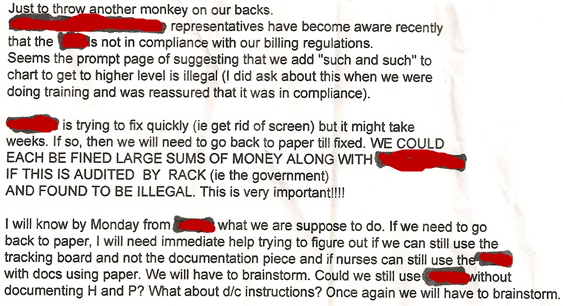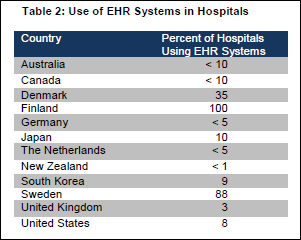"A valid concern..." Oh please. Everyone picks the software they like and the origin of that software is an afterthought.…
News 9/30/09
HERtalk by Inga
From: Overworked “Re: UCSF cancels GE Centricity project & lays off 33 IT analysts & support staff. Was this reported already somewhere? I work with a pharmacist who was formally laid off from UCSF last week and given 2 months severance pay. Apparently UCSFMC cancelled their GE Centricity project three weeks ago and he said he knows of 33 IT analysts and IT support folks that were laid off. He says the GE project budget was blown out of the water within 1 year and it had been going on for over 3 years – he had been on board for 3+1/2 years. He says it wasn’t even close to being implemented. I thought it was interesting that I couldn’t find anything in the press – but forgive me if I’m telling you old news.” Unverified. Dang. Mr. H always accuses me of not reading what he writes but I don’t think we have any official word that UCSF ha terminated its relationship with GE. However, UCSFWatch did send over a note last month suggesting things were not going well. The medical center management had hired Kurt Salmon Associates to figure things out and at that time GE-related activity was on hold.
The North Shore-LIF Health System (NY) announces it is subsidizing up to 85% of the EMR implementation and operating costs for over 7,000 of its affiliated physician. Participating doctors can received subsidies of up to $40,000 each over five years to implement Allscripts EHR. The initial agreement with Allscripts includes licenses for 1,200 doctors and one analyst suggests the deal is worth $20 million. In any case, it’s definitely one of Allscripts’ largest sales ever. North Shore’s subsidy program includes a unique twist: physicians will be subsidized at a rate of either 85% or 50%, depending on whether or not they are willing to allow North Shore to use the EHR to report and share their performance data and allow them to compare it against a set of nationally care and outcome metrics.
Allscripts also announces that Baptist Memorial Health Care (TN) has selected Allscripts EHR/PM to automate its 65 employed and 3,100 affiliated physicians.
Meanwhile, a Jeffries’ analyst upgrades Misys to a buy and predicts the company will sell off each of its three divisions. Speculation is that the first division to go would be the Allscripts segment, which would appeal to buyers like “GE Healthcare and similar major players.” Analyst Milan Radia says, “”Our upgraded price target reflects our view that we are now approaching an end game in the transformation of Misys.”

A reader forwarded the attached copy of an email sent to all the ER docs at his hospital. He explained to me the ER recently adopted a new documentation system and is now paperless. However, authorities are now questioning if the system is in compliance with billing regulations because it prompts users to add certain items in earn a higher level service. If the “experts” determine that the system is out of compliance, the hospital will likely need some sort of fix from the vendor. In the worst case, the hospital (and presumably others in its chain) will have to revert to paper for some amount of time. I asked a reader his opinion, and he believed that technically the system was “legal” because the doctor still has to approve the code. However, he suggests it is a tricky game that can invite “serious auditing.” Any other opinions?
If you are a careful reader, you will have noticed that Mr. H left me to my own devices this week while he is out gallivanting the world. We always joke about how I would handle things if some major IT story broke while he was out of pocket, like someone buying Cerner or Judy Faulkner resigning from Epic. I’m thinking that Xerox’s acquisition of ACS was just a warm-up for some really big, breaking story during Mr. H’s next vacation. Investors, by the way, appeared lukewarm on the merger, and Xerox’s stock price fell 15% on Monday. The $5.7 billion cash and stock deal allows Xerox to expand its footprint into the services business, not unlike HP’s EDS purchase last year and Dell’s recently announced bid to buy Perot.
Cerner and the University of Missouri announce a $100 million partnership that reassigns about 100 workers from the UM Health System to Cerner. The plan calls for the creation of the Tiger Institute of Health Innovation, which will be tasked with designing innovations to improve patient care and population health. University and Cerner officials say the collaboration could improve patient safety and save the state $1 billion (sounds optimistic.) As part of the 10-year agreement, the university and Cerner would split profits from any new developments based on the amount of money each invests in the institute. A portion of the proceeds would be used to continue funding the institute. Former Ascension Health CIO Sherry Browne will lead the institute.
Accretive Health, a provider of RCM services, files for a $200 IPO.
HHS Secretary Kathleen Sebelius announces $27.8 million in ARRA awards, including 18 grants totaling $22.6 million for EHR implementations. The balance will support various HIT projects, including HIEs and helping existing health centers use existing EHRs to improve patient health outcomes. Think how fun it must be to be Sebelius, handing out millions of dollars to grateful recipients every couple of weeks. Almost as good a gig as Santa Claus
The Hannaford Charitable Foundation presents Health Quest (NY) a $50,000 donation to help fund its CPOE project. This is the second such gift from the foundation that was created by the Hannaford supermarket chain. Health Quest is investing about $60 million to overhaul its IT infrastructure, including implementation of a Cerner system.
Freshmen at Indiana University are embracing the school-supplied PHR, with 40% already using the program just weeks after the start of school. NoMoreClipboard.com is the PHR vendor.
The State University of New York at Stony Brook expands its deployment of PatientKeeper products, adding the ePrescription and Pay for Performance applications.
Nuance Communications announces the availability of version 9 of its eScription application. Among other changes, version 9 offers advancements in document quality review and administrator efficiency.
The Lake Erie Regional Health System/TLC Health Network is awarded a $4 million grant towards a $5.6 million IT integration project between the Brooks Memorial Hospital and TLC Health Network facilities. The grant is part of $436 million in funds being distributed through the Health Care Efficiency and Affordability Law of New York State.
RelayHealth says that both Hill Physicians Medical Group (CA) and Montefiore Medical Center (NY) have improved care collaboration, patient satisfaction, and specialty treatment prioritization using RelayHealth’s referral management service. The product, which was co-developed with Hill Physicians, facilitates secure health information exchange between primary care providers and specialists.
West Georgia Health System signs a seven year deal with Perot Systems for revenue cycle services to the hospital organization. Perot just recently provided the health system support services to implement MEDITECH 6.0.
Speaking of Perot, I was sad to hear that the individual charged with insider trading ahead of Dell’s proposed purchase of Perot was one of the heroes in the 1979 Iranian hostage rescue. If you aren’t familiar with the story, Ross Perot spearheaded a mission to rescue two of his employees held hostage in an Iranian jail. Reza Saleh was an EDS employee at the time and led the mob that broke into the prison and ultimately rescued the hostages. The SEC has now charged Saleh of making $8.6 million in illicit profits from the Perot/Dell deal.
Hudson Headwaters Health Network, a network of 16 community health centers in upstate New York, receives a $7 million grant to finance HIT and a medical centered home initiative.
A new report from the Information Technology and Innovation Foundation finds that Finland, Sweden, and Denmark are the clear global leaders in terms of EHR adoption in hospitals. Those countries also ranked far better in their use of electronic prescribing and CPOE. At least we beat the Brits and New Zealand.
University Hospitals (OH) makes plans to rent a closed school to train more than 4,000 employees on its new Eclipsys Sunrise EMR system. The health system wants 6-day-a-week, 24-hours-a-day access to the school from January to June.
Cumberland Consulting Group is named one of 2009 Best Small Firms to Work for by Consulting Magazine.
The CDC issues $4.37 million in grants to fund four new Centers of Excellence in Public Health Informatics. The recipients will use the funds to enhance HIT and improve the detection of and response to emerging public health interests. Winners are Harvard Pilgrim Health Care, Indiana University, the University of Pittsburgh, and the University of Utah.
Warning: if you are an HIT purist, feel free to mosey along and not read this last note. For the rest of you, here is an amazing statistic: more than 2 billion applications have been downloaded from Apple’s App store since July, 2008. More than 85,000 apps are currently available, and only about 18% of the downloaded apps are paid for. However, the average cost of paid applications is growing and US revenues for applications will grow 10 times between 2009 and 2013, reaching $4.2 billion. I downloaded my first paid application recently: Scrabble ($4.99) and I am totally addicted.








…Those countries also ranked far better in their use of electronic prescribing and CPOE. At least we beat the Brits and New Zealand…
Though New Zealand did bring us Jemaine and Bret.
The UCSF rumor is true and unfortunate. Unfortunate for the 33 IT Staff who worked very hard to try to implement a very, very bad solution; and upper management who was completely disconnected to the project. They connected only when it was time to save their shirts!
Re: ER billing prompt page
Vendor is T-Systems.
The conflicted DeParle, a shill for the HIT industry, together with the Secretary, have wasted taxpayers’ funds on vapourware.
The conflicted DeParle, a shill for the HIT industry, together with the Secretary, have wasted taxpayers’ funds on vapourware.
How does the North Shore deal work with the Stark regulations? I know those were loosened up, but this seems to not comply with the spirit of even the looser version of them, which I understood required physicians to pay for at least a reasonable % of the system.
I have also heard the rumor that such screens that recommend “up-coding” are illegal, but that they actually aren’t illegal, just frowned upon, especially if they’re worded like “just add one more ROS and you get more $$$!!!”. There are many vendor solutions that effectively have the same screens and you don’t see problems all over the place. Probably what happened is that their Compliance office became uncomfortable, told them they needed to get rid of it, and since most people don’t understand the difference between law, regulation, and guidance, they’re now calling it “illegal”. Of course, everybody you ask has a different answer on this one, so YMMV.
The physicians at UCSF are to be commended for their foresight, realizing in advance that the CPOE systems that were being contemplated would disrupt care and endanger patients. The safety hospitalist Bob Wachter has written about this system of tomorrow (many tomorrows)on his blog.
It is politically correct to blame the deinstallation on money.
Doing so protects the secret being kept by the entire industry of CPOE makers: THEY ARE DANGEROUS AND ARE NOT READY FOR PRIME TIME USE.
For those who do not believe this, read about England’s foray into HIT, available at Health Care Renewal, courtesy of Scot Silverstein, MD.
Gee, Cepy Oui, I wonder how Finland, Sweden and Denmark keep their patients safe if CPOE is DANGEROUS AND NOT READY FOR PRIME TIME.
The dealings of Cerner with Missou merit a closer look. The goals of their business venture at first blush appear socially responsible.
This is a smokescreen for clandestine experimentation.
Will Missou’s IRB sign off on the experiments that “could improve patient safety and save the state $1 billion (sounds optimistic.)”?
“As part of the 10-year agreement, the university and Cerner would split profits from any new developments based on the amount of money each invests in the institute.”
There is need to protect the patients’ lives that are put in jeopardy by programs using experimental care giving HIT devices in which the profit motive is the priority of both businesses.
This is a bonafide conflict of interest.
Mrs Tollbooth: Perhaps Cepy Oui was referring to the US vendors/makers of CPOE software and not CPOE in general? Although I don’t know what vendor the Finns use.
Lol…you took the words right out of my mouth Mrs. Tollbooth. What is dangerous about a CPOE system? The system or the provider using them? I have been in go-lives where a nurse thought the mouse was a foot pedal like you would see on a sewing machine or that you needed to physically take the mouse and move it around ON the screen. Some of the smartest people in the world are our clinicians. Not only do these clinicians USE the system but they are also the developers & sponsors of the systems with the vendors providing them.
May be instead of saying they are “DANGEROUS” and “NOT READY FOR PRIMETIME”, you could take off your Negative Nancy glasses and learn how to use the system. Yes, it is a change to your workflow…one that is incredibly dated and wrought with chances for mistakes. So instead of being a vocal annoyance, you could try and refocus that energy into suggestions for improvement of these systems? I am sure even some of the big boys would be willing to pay you for your suggestions as well.
The % for usage in Finland are for EHR usage, not CPOE. Reading the article (I didn’t get down to read the article references) it sounds like the % for CPOE is “high”, but that sounds like it’s based primarily on lab OE usage because their reasoning behind saying it’s high is because all of the hospitals use LIS systems that have OE that they use. Probably need to track the references down to get under that statistic even more. No mention of vendor.
Talltooth and Pez are obviously not aware of the HIT lobby and payoffs nor of the contractual clauses to not disclose adverse events.
As for POE in Scandinavia, there is at least one good system (but not from a US company).
In Sweden, the FDA counterpart, SMPA, has recognized that POE extends formidable risks to the patient, and has established regulation to keep companies from selling POE products that are defective, and enables (requires) the reporting of adverse events.
It behooves the US FDA to follow suit. The benefits of reducing medication errors from POE, if any, are negated by the multitude of other errors that such ill designed device software cause, even in the most computer savy and best clinician’s hands.
Talltooth and Pez are obviously not aware of the HIT lobby and payoffs nor of the contractual clauses to not disclose adverse events.
Actually, I’m pretty sure the claims of non-disclosure contracts were debunked in this very blog.
the Cerner / Missou partnership sounds dangerously similar to the GE / Intermountain HealthCare (IHC) Partnership from several years ago. At least the $100 million part…Are GE & IHC still talking? I know that AGFA took at least 10% of that partnership last year in a PACS deal…
If Programmer is correct, then UCSF should provide its wisdom to all of us. Let us hear the details of their dysfunctional HIT equipment.
UCSF, are you listening and will you disclose to help us protect the safety of our patients?
I challenge you to a game of scrabble!
Any more fodder regarding Misys?
Cepy Oui wrote:
“The physicians at UCSF are to be commended for their foresight, realizing in advance that the CPOE systems that were being contemplated would disrupt care and endanger patients… For those who do not believe this, read about England’s foray into HIT, available at Health Care Renewal, courtesy of Scot Silverstein, MD.”
Don’t forget the story about the attempted UCSF/Stanford merger a decade ago. IT failures of today are deja vu all over again:
“A thousand MIS personnel cannot merge two healthcare systems?”
http://www.ischool.drexel.edu/faculty/ssilverstein/failurecases/?loc=cases&sloc=A%20thousand%20MIS%20personnel%20cannot%20merge%20two%20healthcare%20systems
heh…there’s a reason nobody has said a word about Intermountain and GE in 2009…doubtful there will be a response from UCSF…the remaining employees surely have been told to keep their mouths shut regarding the Centricity product they have worked on for years…